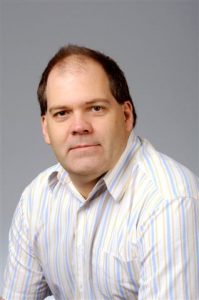
Position:
Associate Professor in the University of Neuchâtel
Background:
Born and raised in Canada, Bruno Therrien studied chemistry at the University of Montreal where he learnt crystallography in the group of André Beauchamp. He left Canada to obtain his Ph.D. in 1998 at the University of Bern Switzerland under the supervision of Thomas R. Ward. He undertook several postdoctoral positions (Weizmann Institute, Massey University, Tokyo University), he currently holds an independent Senior Researcher position at the University of Neuchatel. His main research interests are supramolecular assemblies and biological applications of arene ruthenium complexes.
Role in POLYTHEA:
- Member of the Supervisory Board
- Leader of WP 3 – Communication, exploitation of results and innovation to market
- Co-supervisor of ESRs 4 & 10
Key publications:
- The « complex-in-a-complex » cations [(acac)2MÌRu6(p-PriC6H4Me)6(tpt)2(dhbq)3]6+ (M = Pd, Pt): a Trojan Horse for cancer cells
B. Therrien, G. Süss-Fink, P. Govindaswamy, A. K. Renfrew, P. J. Dyson, Angew. Chem. Int. Ed. 2008, 47, 3773-3776. - Ruthenium-porphyrin compounds for photodynamic cancer therapy
F. Schmitt, P. Govindaswamy, G. Süss-Fink, W.H. Ang, P.J. Dyson, L. Juillerat-Jeanneret, B. Therrien, J. Med. Chem. 2008, 51, 1811-1816. - Organometallic cages as vehicles for intracellular release of photosensitizers
F. Schmitt, J. Freudenreich, N.P.E. Barry, L. Juillerat-Jeanneret, G. Süss-Fink, B. Therrien, J. Am. Chem. Soc., 2012, 134, 754-757. - Designing supramolecular liquid-crystalline hybrids from pyrenyl-containing dendrimers and arene-ruthenium metalla-cycles
A. Pitto-Barry, N. P. E. Barry, V. Russo, B. Heinrich, B. Donnio, R. Deschenaux, B. Therrien, J. Am. Chem. Soc., 2014, 136, 17616-17625.
Links:
https://www.unine.ch/chs/home/collaborateurs-scientifiques/prof-bruno-therrien.html
https://www.researchgate.net/profile/Bruno_Therrien

